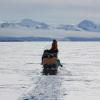Climate & Environment
- <p><span>University of Colorado Boulder students, along with experts from government and industry, will focus on student research and topics including energy storage and cooperation with China during the fourth annual Energy Frontiers conference April 4.</span></p>
<p>The event, organized by the CU Energy Club, is free and open to the public and will be held from 10 a.m. to 5 p.m. in the Glenn Miller Ballroom of the University Memorial Center. The conference includes a poster session, panel discussion, catered lunch and a career fair.</p> - Steven Hayward has been appointed the first Visiting Scholar in Conservative Thought and Policy, the University of Colorado Boulder announced today.
Hayward, Thomas W. Smith Distinguished Fellow at the Ashbrook Center at Ashland University in Ohio, will begin his one-year appointment in the fall. - <p> </p>
<p>A team led by the University of Colorado Boulder looking for clues about why Earth did not warm as much as scientists expected between 2000 and 2010 now thinks the culprits are hiding in plain sight -- dozens of volcanoes spewing sulfur dioxide.</p> - <p> </p>
<p>Creeping climate change in the Southwest appears to be having a negative effect on pinyon pine reproduction, a finding with implications for wildlife species sharing the same woodland ecosystems, says a University of Colorado Boulder-led study.</p> - <p>A new study by an international team of scientists analyzing ice cores from the Greenland ice sheet going back in time more than 100,000 years indicates the last interglacial period may be a good analog for where the planet is headed in terms of increasing greenhouse gases and rising temperatures.<br /><br /></p>
- <p>When a sun-gazing NASA satellite designed and built by the University of Colorado Boulder launched into space on Jan. 25, 2003, solar storms were raging.</p>
- <p>A new NASA-led study involving the University of Colorado Boulder finds that when it comes to combating global warming caused by emissions of ozone-forming chemicals, location matters. </p>
<p>Ozone is both a major air pollutant with known adverse health effects and a greenhouse gas that traps heat from escaping Earth’s atmosphere. Scientists and policy analysts are interested in learning how curbing the emissions of ozone-forming chemicals can improve human health and also help mitigate climate change.</p> - <p>To reflect its broader focus, the Colorado Renewable Energy Collaboratory, a research consortium including the University of Colorado Boulder, the Colorado School of Mines, Colorado State University and the U.S. Department of Energy’s National Renewable Energy Laboratory has adopted a new name: the Colorado Energy Research Collaboratory.</p>
 <p>Gaping crevasses that penetrate upward from the bottom of the largest remaining ice shelf on the Antarctic Peninsula make it more susceptible to collapse, according to University of Colorado Boulder researchers who spent the last four Southern Hemisphere summers studying the massive floating sheet of ice that covers an area twice the size of Massachusetts.</p>
<p>Gaping crevasses that penetrate upward from the bottom of the largest remaining ice shelf on the Antarctic Peninsula make it more susceptible to collapse, according to University of Colorado Boulder researchers who spent the last four Southern Hemisphere summers studying the massive floating sheet of ice that covers an area twice the size of Massachusetts.</p>- <p> </p>
<p>Gaping crevasses that penetrate upward from the bottom of the largest remaining ice shelf on the Antarctic Peninsula make it more susceptible to collapse, according to University of Colorado Boulder researchers who spent the last four Southern Hemisphere summers studying the massive floating sheet of ice that covers an area twice the size of Massachusetts.</p>


